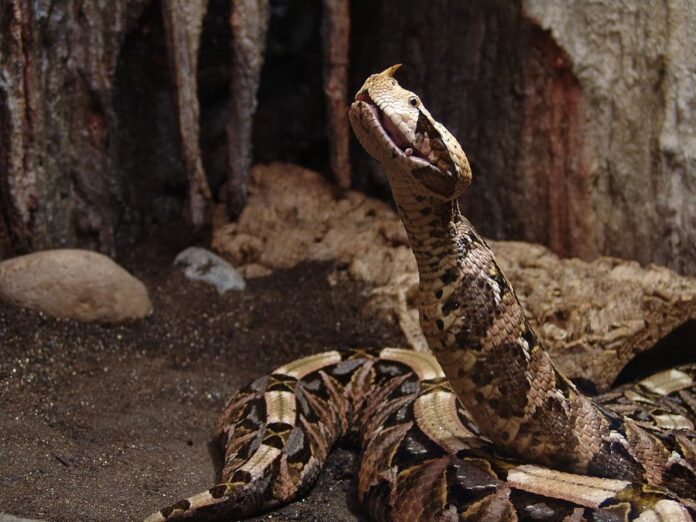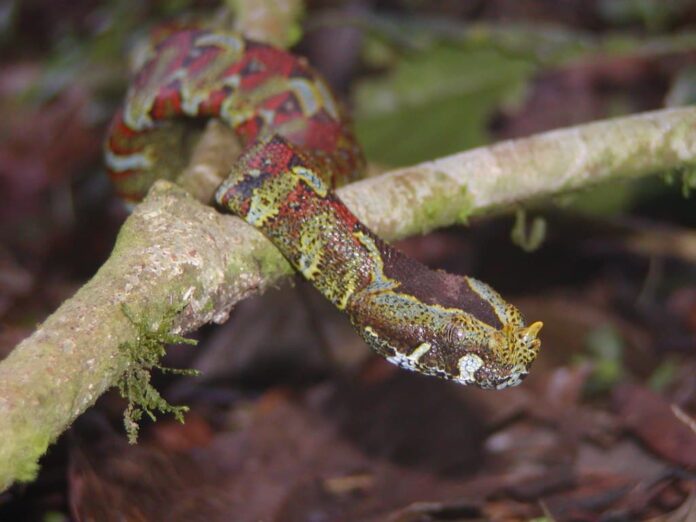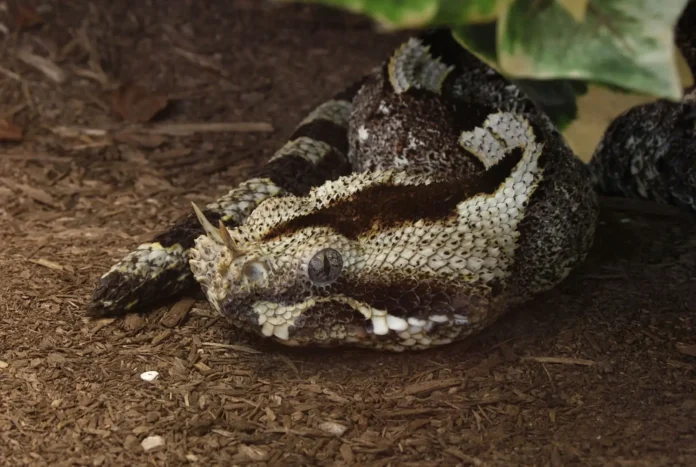Rhinoceros viper? Looks more like a dragon to me, but this serpent goes by so many other names. Some of the common names are butterfly viper, horned puff adder, rhinoceros horned viper, and rhinoceros puff adder. Every name is associated with its appearance and its prominent horns, and the rhinoceros viper is quite fascinating. You should definitely check out more about them below, this snake is something else.
1Appearance

A rhinoceros viper has a large and stout body that measures from 72 to 102 centimeters long. It has a flat and narrow head that is triangular in shape, and the head is smaller than the rest of the body. The body of this viper has a combination of blue or blue-green oblong markings, each with a lemon-yellow line down the center. Along with that, there are also irregular black and rhombic blotches and dark crimson triangles running down its flanks. They appear the brightest after shedding their skin but the colors usually fade quickly from the dirt and silt.
This venomous snake is famous for its vibrant coloration, and of course, its horn-like scales that got the snake its name. Such a prominent characteristic, their 2 or 3 large horns measure about 2.5 centimeters extending from the end of their nose. The purpose of the horns remains unknown but they do make these vipers stand out from the rest. The combination of their fierce eyes and their scales with the horns makes them look like a striking dragon from the side.
2Behavior
Rhinoceros vipers are nocturnal, so they spend their day time hiding in leaf litter or holes. Their colorations allow perfect camouflage on the forest floor but they do climb into thickets and trees if they need to. On top of being able to climb up to 3 meters above the ground, they are also powerful swimmers as well. Temper-wise, they are not aggressive and they are quite slow-moving but they are not afraid to strike either.
3Feeding & Habitats

As an ambush predator, a rhinoceros viper remains motionless and waits for potential prey to pass. The menu of this viper consists of small mammals but the ones that live in wetland habitats also feed on amphibians and fish.
Rhinoceros vipers are found in many parts of Africa including Central Africa and West Africa. The countries that they are common in include Cameroon, Gabon, the Democratic Republic of Congo, and the Republic of Congo. They inhabit various tropical areas such as rainforests, savannas, and woodlands across regions in Africa. These snakes frequent areas near lakes and rivers; hence the nickname “river jack”. Unfortunately, the rhinoceros viper is a vulnerable species due to deforestation, exotic pet trade, habitat destruction, and capture for skin and venom.
4Venom
The venom of these snakes contains both hemotoxic and neurotoxic venom, even with just a small dose can still be deadly. Its hemotoxic venom is more dominant so the venom attacks the victim’s circulatory system by destroying blood vessels and tissues. Massive swelling after the bite is common, before leading to internal bleeding and necrosis. For a snake with a small head, the fangs of the rhinoceros viper can be quite intimidating. Their fangs can be as long as 1.5 centimeters, and they can quickly strike either forwards or sideways. The good thing is only a few bites have been reported due to their restricted geographic range.
When not in use, the viper will fold its fangs into the roof of its mouth. On top of that, it even has the ability to control the movement of its fangs as well. The other dangerous part? There is coiling or warning before the strike, so you never know when. However, they do hiss to reveal their presence when approached so that’s the head’s up that you will get. The locals said a rhinoceros viper’s hiss is the loudest hiss of any African snake as it is almost like a shriek. I believe that is more than enough for anyone to back away from this viper when they hear it.
Related Post: Deadliest Vipers In The World




